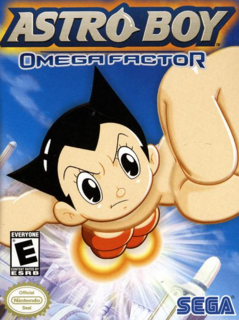Don’t let the game’s colorful and seemingly-childish aesthetic turn you off – this is a seriously fun game...
Astro commands a number of fighting skills as he battles wave after wave of monstrous robot enemies in the game’s 40+ stages. His basic melee attacks include the standard punch and kick combos seen in most side-scrolling brawlers. As a futuristic robot, Astro also has an arsenal of auxiliary weapons such as a finger laser, arm cannon, and –no kidding, here- a gun in his butt. In addition to these attacks, Astro can fly through the air using his rocket-powered feet, and also has powerful sensory equipment to learn more about his environment. But his most powerful ability and what makes Astro special from all other robots is his Omega Factor – a robotic brain that can learn and evolve, giving Astro the ability to grow and even feel human emotion. The controls in Astro Boy are simple, effective and elegant. Astro moves around the screen easily, and his maneuvers are not overly complicated. His arsenal is varied and a power meter called “EX” loosely limits the usage of his more devastating attacks. For the most part, the game is a side-scrolling platformer, but every one in a while, the pace is changed as a flying level is introduced, giving way to a more classical space shooter vibe. As Astro travels from level to level he meets characters from Tezuka’s manga series. Each of these characters adds some small nuance to the overall plot, and serves as a leveling mechanic – with each new character, Astro’s Omega Factor grows and he is able to increase the effective power of one of his other abilities. Many characters are integral to the plot, but many others are hidden, and must be uncovered within their levels or unlocked by performing some action in another level. Astro Boy plays like many other side-scrolling or platform games, and fans of that genre will feel right at home. But while it embraces many elements that are inherent to the genre, the design of the game does it in such a way as to justify these conventions - making them seem more like innovation and less like the same old tricks. As Astro fights his robotic and human enemies, he learns more about his origins and the socio-political agenda of characters around the globe. A war is on the horizon – a war between robots and humans that may result in the destruction of all mankind. Astro comes to play a pivotal role in this war, though to give any more detail would spoil the fun. Suffice to say that by the end of the story, Astro has met and interacted with some forty characters from Tezuka’s series and the scope of Astro’s struggles span both space and time to bring him to an amazing climax. The story is uncharacteristically deep and fulfilling for the genre as most shooters and brawlers are not well known for their plots.
The game also has a lot of replay value for a platform/shooter, and this is again due in large part to the design of the game. After completing the game for the first time (though most will contend that the first “ending” doesn’t count), the player will be compelled to replay the entire game again, this time incorporating past knowledge to change the course of history. From a technical standpoint, this is brilliant. The developers take a normally innocuous convention like Stage-Select and give it meaning and purpose by using the story to justify such ability in the form of time travel. Hopping from level to level makes sense as Astro leaps from one time period to the next, gaining new clues about his destiny and the characters around him until he is eventually able to uncover the great mystery of his creation and his real purpose in the universe. In addition there are time-trial modes for the hardcore gamers, as well as the standard compliment of unlockable sound and video tests. The game sports relatively brief, but challenging levels with unlimited continues - as well as a handy auto-save feature - making the game ideal as a handheld title.
Graphically, Astro Boy is gorgeous. The characters from Tezuka’s manga are lovingly recreated in dialogue sequences that use lush portraits, even going so far as to portray different levels of emotion for the some characters. The backgrounds of each of the various levels and the enemy design are varied and colorful. Several beautiful cut scenes are also included as each chapter unfolds to help tell the intricate story. The game’s score is nothing particularly special. It is neither stunning nor grating. Rather, it merely accomplishes its task of providing some interesting background noise to accompany the general array of sound effects.
As a total package, Astro Boy: Omega factor is a home-run. The game is simple to pick up and play, but still challenging. It has a traditional shooter/brawler format, but never grows state or repetitive. The visuals and sound are nearly perfect, and the story is at times both sprawling in its enormity and touching in its intimacy. Any fan of the side-scrolling genre should enjoy this title, so don’t let the game’s colorful and seemingly-childish aesthetic turn you off – this is a seriously fun game.

